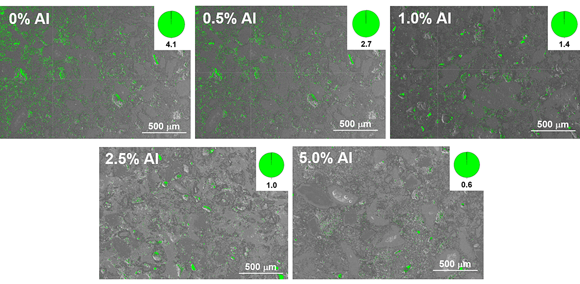Study reports on the addition of aluminium to sintered CuCrFeNiTi and its potential for automotive components
January 4, 2023

A team of researchers led by Dr Enrique Rocha-Rangel at the Universidad Politécnica de Victoria, Mexico, and Dr Ivanovich Estrada-Guel of the Centro de Investigación en Materiales Avanzados, Mexico, have published the results of a work looking at the addition of aluminium to sintered CuCrFeNiTi, and its potential as an alloy for the production of automotive components.
Published in Metals, a peer-reviewed journal from MDPI, the work centred around CrCuFeNiTiAlx high-entropy alloys processed through Powder Metallurgy. High-entropy alloys (HEAs) are advanced materials with at least five elements present in equimolar or near-equimolar amounts, and have attracted significant attention from the scientific community due to their potential applications.
The authors explain that in the automotive sector, vehicle moving parts wear out over time so they must be replaced before failure. Often, these are vital components for the engine’s proper functioning, and examples include internal combustion engine valves and valve seats, aluminium cylinder liners and cast-iron piston rings or rocker arms. These components are often made of alloys that provide an adequate mechanical strength-to-weight ratio; however, the weight is significant since excessive mass limits the engine’s ability to reach high revolutions.
Many high-entropy alloys have been developed with exceptional mechanical response such as increased strength, good ductility, excellent fracture toughness, good creep, wear resistance, chemical and thermal stability in comparison to traditional alloys. HEAs mainly have been processed through traditional melting methods that have the disadvantage of microstructural heterogeneity and heavy element segregation, it is stated. On the other hand, when using Powder Metallurgy the tendency toward random distribution of atoms (chemical disorder) is favoured and leads to extending the solid solubility limit and improving their mechanical properties. Therefore, there are great expectations for high-entropy alloys that can be used in the automotive sector.
Until now, the CuCrFeNiTiAlx system has not been studied in detail; the effect of adding aluminium to the system has yet to be reviewed. However, it could represent interesting properties due to the additional phase changes that could be generated in addition to the tendency of the alloy to form a mixture of FCC + BCC phases. The objective of the work is focused on the characterisation of the CrCuFeNiTi system with Alx (x = 0, 0.5, 1, 2.5, 5 mol %) produced by PM to evaluate the effect of Al on the phase and microstructural evolution of the alloy, and determine its potential application in vehicle parts.
The authors concluded that the HEA alloy that achieved the highest hardness was the one with the highest Al content. These alloys harden significantly with the addition of Al due to the increase of the chromium oxide-type phase, and the strong atomic bonding between Al and other elements, due to the larger atomic radius of Al. This phenomenon is also related to the reduction in porosity as a function of aluminium content.
The full paper is available here: Study of Al Addition on Sintered CuCrFeNiTi as a Potential Alloy for Automotive Components.














